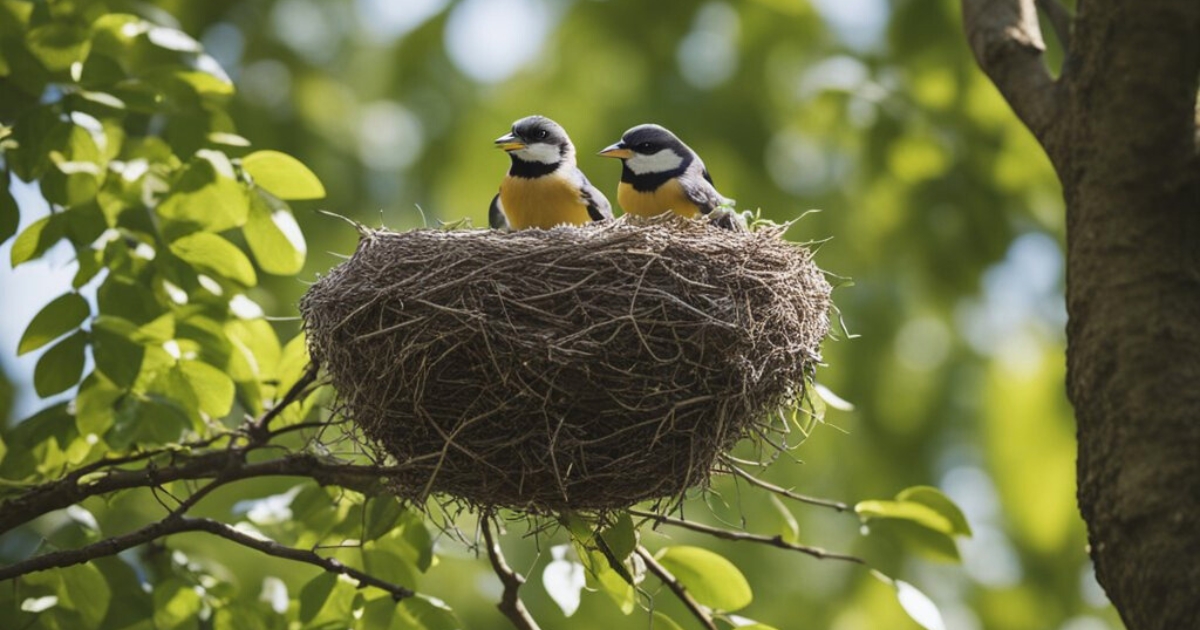Bird reproduction is a fascinating process that has evolved remarkably different strategies compared to mammals. There is no internal pregnancy like in humans. Rather, fertilization happens internally, but then eggs are laid externally to be incubated. It takes intricate courtship rituals, mating, egg formation, brooding, and parental care for birds to successfully reproduce. Understanding the specifics provides great insight into the biological adaptations that enable our fine feathered friends to pass on their genes.
Elaborate Courtship Rituals
Long before the physical act of mating occurs, many bird species perform elaborate courtship displays to locate a suitable mate and form an intimate pair bond. Courtship establishes their readiness and willingness to breed.
Attracting Attention
Male birds, in particular, have evolved showy plumage and behaviors meant to grab the attention of females. Bright colors, dramatic feather displays, aerial dances, and melodious songs all help spark a female’s interest during breeding seasons. Ornate nests may also be built to entice birds to settle down.
Species-Specific Rituals
Each bird species has uniquely structured courtship rituals passed down genetically and learned through observation. Elaborate mating rituals help identify appropriate healthy mates and prevent hybridization between species. Familiar displays build trust and rapport between the pair.
Bonding Behaviors
Courtship also serves to strengthen social ties between the mating birds. Mutual feeding, preening feathers, synchronized displays, and repeated copulations all help affirm the pair’s bond before nesting duties divide their attention. Solid bonds facilitate cooperative parenting duties.
Courtship establishes receptivity, synchronizes reproduction timing, and ensures parental cooperation – all critical factors before the physiological demands of actual fertilization and offspring care begin. The rituals trigger biological readiness in both sexes at ideal times.
The Physical Mating Act
After courtship leads to a bonded pair reaching sexual receptivity, actual bodily mating occurs. This act completes the fertilization process.
Positioning and Mounting
The male climbs atop the female and balances himself over her back using his wings. The female cooperatively crouches lower and raises her tail upwards to facilitate the cloacal kiss transfer of sperm.
The Cloacal Kiss
Bird sex organs are internal. Rather than direct penetration, males have a bump or cloacal protrusion above the cloaca vent that makes contact with the female’s cloaca opening. This “cloacal kiss” brings sperm and ova together.
Quick Copulations
Bird couplings are often quite brief, lasting just seconds or minutes compared to longer mammalian matings. However, pairs may separate and then repeat the act numerous times within a breeding bout to ensure sufficient sperm transfer.
The mating act itself occurs rapidly but fulfills the crucial task of joining male and female genetic material. Activity usually happens at the nesting site to deposit sperm before an egg develops. With sperm in place, the complex process of ovulation and fertilization ensues within the female.
Fertilization and Egg Formation
After mating introduces sperm into the female reproductive tract, a carefully timed process begins to fertilize eggs and prepare them for laying.
Internal Fertilization
As with mammals, fertilization happens inside the female’s body. The sperm and ovum join deep within specialized storage tubules along the ovary. This protects the early zygote before the shell forms.
Yolk Development
Once the ovum is fertilized with genetic material, it begins growing dramatically into a yolk sphere, encapsulating the embryo and food reserves. The ripe yolk then progresses through the oviduct.
Shell Formation
As the yolk passes through the shell gland region of the oviduct, calcium carbonate is deposited around it to create the egg shell and protective membranes. Pigments produce patterning.
The external egg is key, as birds cannot supply nutrients internally. The female’s body closely controls this process to produce sufficient, high-quality eggs during optimal seasons. Once complete, eggs exit through the shared cloaca.
Gestation and Brooding
Unlike mammals, birds do not carry developing young internally. The fertilized eggs must be carefully incubated over a growth period by the parents.
External Eggs
After shell formation, eggs are laid externally rather than continuing gestation within the female. Clutches of multiple eggs are often laid days apart before beginning warm incubation.
Shared Brooding
Parents take turns sitting atop the eggs for warmth and protection in the nest. The male may incubate the eggs by day while the female broods at night. Constant temperature and humidity is maintained.
Full Term Incubation
Depending on the species, bird eggs hatch after an incubation period ranging from 11-80 days. The parents patiently keep the eggs nurtured until the point of hatching.
Shelled eggs allow birds to continue flying during reproduction, but they also necessitate extensive parental care to progress embryonic growth outside the female’s body. Both sexes cooperate to nurture the fertilized eggs.
Parental Care
Bird parenting extends well beyond the challenges of egg incubation. The adults must raise and teach the hatchlings until independence.
Feeding and Protection
For days to months after hatching, the chick’s parents provide food, warmth, and protection from predators. They quickly return to keep the nest replenished with regurgitated food to fuel the chicks’ growth.
Teaching Essential Skills
Bird parents give vital lessons in finding food sources, avoiding dangers, migrating routes, communication, and social behaviors to pass down survival knowledge. Hands-on learning gets chicks ready for independence.
Fledging and Dispersal
As wings develop, chicks will make their first flights from the nest, known as fledging. Parents continue nurturing fledglings on the ground and teaching them survival skills. Eventually, the young fully mature and disperse to breed in the coming seasons.
Extensive biparental care is integral to reproductive success in birds, thanks to their externally laid eggs. Mating pairs cooperate to nurture and teach the next generation until maturity.
Bird Reproductive Systems
The specialized reproductive anatomy of birds supports their breeding strategies.
Male Structures
Male birds have paired testes within their abdominal cavity that produce sperm. The sperm move through the vas deferens ducts to be stored as semen in the cloaca until mating.
Female Structures
Females possess only a left ovary and oviduct for limited egg production. Eggs develop sequentially in the ovary before passing through the oviduct regions for fertilization, yolk growth, and shell formation.
Shared Cloacal Exit
The cloaca is a shared chamber where sperm or eggs exit and the digestive system ends. The cloaca connects to the exterior through the vent or anus.
Streamlined equipment reduces excess body mass. Eggshells and shelled young allow for smaller reproductive systems compared to placental mammals, which must wholly support prolonged internal gestation.
Evolution of Avian Breeding
Birds evolved these specialized reproductive strategies as beneficial adaptations for active, mobile life in the air.
Flight-Friendly Eggs
Heavy, growing young would hinder the flight needed for feeding and escaping predators. External eggs with portable shells optimize reproduction for soaring species.
Mating without Genitals
Mating by cloacal contact avoids cumbersome mating organs that would create excess drag and weight issues in flight. Simple internal fertilization preserves aerodynamics.
Greater Independence
With the male only contributing sperm, the female can incubate alone if needed after mating. Shelled young also mature faster than placental mammal young, requiring less paternal care in some species.
Streamlined equipment reduces excess body mass. Eggshells and shelled young allow for smaller reproductive systems compared to placental mammals, which must wholly support prolonged internal gestation.
Key Differences From Mammals
Bird and mammal reproduction have evolved very different reproductive strategies as adaptations to their environments.
External Eggs
Birds lay acellular shelled eggs fertilized internally but incubated and hatched externally. Mammals support prolonged internal fetal development through gestation.
No Live Birth
Because of the egg shell, baby birds do not experience live birth or nursing. Mammals deliver active, live young who are fed milk from mammary glands.
Frequent Cycling
Female birds enter breeding conditions earlier and more often each season than mammals, laying numerous eggs in sequential clutches. Mammals have longer gestation periods between birth cycles.
While both ultimately undergo internal fertilization, the divergent paths of egg laying versus live birth have necessitated very different anatomical equipment and breeding strategies between birds and mammals. Their shared ancestry is visible in some reproductive structures, like the cloaca. But adaptation has molded processes specialized for each group’s lifestyles and environments over the eons. There are even some unusual mammals, like monotremes, who lay eggs too! Nature is diverse.
People Also Read:
Conclusion
Bird reproduction is a complex dance of mating behaviors, internal fertilization, and extensive external parental care. Their signature egg adaptation allows birds to take flight and colonize diverse habitats in amazing ways. But eggs also require sophisticated courtship rituals between mates as well as diligent care for egg incubation and chick-rearing to be successful. Parents cooperate in brooding shifts and providing food once chicks hatch. From spectacular mating displays, to intricately formed eggs, to attentive parental nurturing, the avian reproductive cycle is a wonder to behold. Their time-tested breeding strategies balance efficiency and mobility with generosity of care for the next generation. The incredible efforts birds undertake to select mates, copulate, lay nutrient-rich eggs, brood, feed hatchlings, and teach fledglings demonstrate the astounding levels of biological investment possible in passing on genes and protecting young. Their endless devotion continues the long evolutionary success story of our feathered friends.
Frequently Asked Questions
How long are birds pregnant before they lay eggs?
Birds are not pregnant in the same way as mammals. Eggs are fertilized internally but then laid externally to incubate. The time between copulation and laying while the egg forms ranges from just 1 day in small finches to 10 days or longer in larger birds like geese.
Which parent bird incubates the eggs?
Usually both the male and female share brooding duties. They switch off sitting on the nest often, with one providing warmth through the night and another taking over during the day. This allows both to still get nutrition. In some species, the male incubates more; in others, the female takes the majority.
Do bird eggs develop inside the female?
No, unlike mammals, bird embryos do not grow inside the female while she is pregnant. Eggs are laid at an early blastula stage. Embryonic development happens externally over an incubation period while parents keep the eggs warm.
Do mother birds feed babies milk like mammals?
No, newly hatched chicks do not nurse milk. With no nipples or mammary glands, parent birds feed newly hatched chicks regurgitated food. As chicks grow, parents bring seeds, insects, or other diet items.
How do baby birds get out of eggs when they hatch?
Using an egg tooth on their beak, chicks peck a hole around the top of the egg to break out of the shell. The parents may also help chip away the cracked shell to free the damp hatchling, who will rapidly gain strength and dry off its downy feathers.

